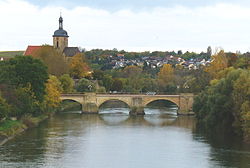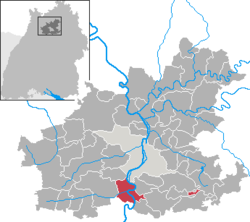Lauffen am Neckar
| Lauffen | ||
|---|---|---|

Neckar bridge at Lauffen
|
||
|
||
| Coordinates: 49°05′0″N 9°09′0″E / 49.08333°N 9.15000°ECoordinates: 49°05′0″N 9°09′0″E / 49.08333°N 9.15000°E | ||
| Country | Germany | |
| State | Baden-Württemberg | |
| Admin. region | Stuttgart | |
| District | Heilbronn | |
| Government | ||
| • Mayor | Klaus-Peter Waldenberger | |
| Area | ||
| • Total | 22.63 km2 (8.74 sq mi) | |
| Elevation | 175 m (574 ft) | |
| Population (2015-12-31) | ||
| • Total | 11,042 | |
| • Density | 490/km2 (1,300/sq mi) | |
| Time zone | CET/CEST (UTC+1/+2) | |
| Postal codes | 74344-74348 | |
| Dialling codes | 07133 | |
| Vehicle registration | HN | |
| Website | http://www.lauffen.de/ | |
![]() Lauffen am Neckar (Lauffen) is a town in the district of Heilbronn, Baden-Württemberg, Germany. It is situated on the river Neckar, 9 kilometres (6 miles) southwest of Heilbronn. The town is famous as the birthplace of the poet Friedrich Hölderlin and for its quality wines – in particular the “Lauffener Katzenbeißer Schwarzriesling“.
Lauffen am Neckar (Lauffen) is a town in the district of Heilbronn, Baden-Württemberg, Germany. It is situated on the river Neckar, 9 kilometres (6 miles) southwest of Heilbronn. The town is famous as the birthplace of the poet Friedrich Hölderlin and for its quality wines – in particular the “Lauffener Katzenbeißer Schwarzriesling“.
Lauffen is located in the southern part of the district of Heilbronn, 9 km (6 mi) south of Heilbronn and 50 km (31 mi) north of the capital of Baden-Württemberg, Stuttgart, on the Neckar. The small river Zaber flows into the Neckar at this point. The neck of the previous great bow in the course of the north-flowing Neckar was broken through by erosion somewhere between 400 BC and 100 BC and for several centuries the watercourse survived as a ring of lakes. The old circular riverbed is now dry, apart from one small artificial lake. Along the old riverbed, a round hill was formed – its slopes now partially covered by the Kaywald forest and with other areas given over to the cultivation of vines. There is a hill on the western bank of the Neckar at the centre point of the ancient river bow. This hill became separated from another on the present eastern bank when the river broke through. Lauffen grew up on the western bank, on the ridge which is the site of today’s Regiswindis Church. This hill settlement became known as Lauffen-Dorf (Lauffen village). In the middle of the river, between the two hills, is an island with a castle. This castle, originally the seat of the Earls of Lauffen, is now home to the town hall – the island itself is a nature reserve. Another settlement, Lauffen-Stadt (Lauffen town), later established itself on the hill on the eastern bank. The two districts, Lauffen-Dorf and Lauffen-Stadt, are joined by a bridge. A smaller bridge from Lauffen-Stadt leads to the island and the town hall. Yet another district, the so-called Lauffen-Dörfle (Lauffen little village), grew up around a convent and is situated on the western bank to the north of Lauffen-Dorf and the Zaber. An exclave of Lauffen, the town's forest of Etzlenswenden, is located further east in the Löwenstein Mountains. It is presumed that this forested area was allocated to the town by its founders in around AD 1200, as there was no other forest within its boundaries from which timber and firewood could be obtained. It is here, in the exclave, that the highest point is situated 452 m (1,483 ft) above sea level; the lowest point 154 m (505 ft) above sea level is by the Neckar.
...
Wikipedia



